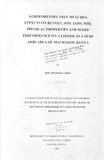| dc.description.abstract | The effects of mulch from the foliage of Grevillea robusta, Cassia siamea and
Gliricidia septum on selected soil physical properties, runoff, soil erosion and
maize performance on a lixisol in Machakos, a semi arid area of Kenya, were
investigated. The study covered five rain seasons from October 1993 to March
1996 and was based on a randomized complete block design of seven treatments
replicated four times.
The seven treatments were; Maize crop with no mulch as the control, maize crop
with 2.24 and 4.48 t ha' dry Grevillea robusta mulch, maize crop with 2.24 and
4.48 t ha" fresh Cassia siamea mulch, and maize crop with 2.24 and 4.48 t ha'
fresh Gllricidia sepium mulch. Surface mulch was applied once, at the beginning
of each season but in order to investigate the residue effects of mulching, no mulch
was applied during the last season of the experiment.
Results showed that surface mulch cover reduction is dependent on many factors
and is highly variable regardless of 'the mulch type and application rate. It is
equally difficult to predict surface mulch cover reduction although a general trend
can be established. The experiment further showed that throughout the seasons,
Cassia siamearetained the highest surface mulch cover followed by Gliricidia
sepium and lastly, Grevillea robusta.
Soil surface mulching has the potential to improve some soil physical properties
but at a rather slow rate and depending on the mulch characteristics.
For the study site, soil temperature and soil moisture evaporation were effectively
regulated when percentage mulch cover was high. Soil moisture release by the soil
matrix improved with mulching as did water infiltration.
In terms of crop performance and the grain and biomass yields, the plots under
Gliricidia septum had the best results followed by Cassia siamea plots, then the
xxi
control plots and lastly plots under Grevillea sepium mulch.
Mulch from Cassia siamea was more effective in runoff and soil erosion control
than in crop performance. It was vice versa for the mulch from Gliricidia sepium.
,
Grevillea robusta mulch was only fairly effective in runoff and soil erosion control
and poor in enhancing crop performance.
Soil surface mulching using agroforestry tree foliage is a good technology in the
management of soils in semi arid areas. For increased benefits, the objective of
applying the mulch must be clear because the choice of the mulch type and the
application rate must depend on the soil fertility status and the objective of
mulching.
This research recognizes that soil profile moisture is not the best indicator of the
effectiveness of mulching on moisture conservation where there is a test crop. A
more comprehensive approach, such as water use efficiency or a water balance, is
recommended. Further, the impact of the studied tree species on the soil biological
and chemical properties and the thresholds for mulch quantities ought to be
determined and evaluated. Rainfall interception and storage capacity of the leaf
biomass at different percentage cover values should also be investigated. | en |

